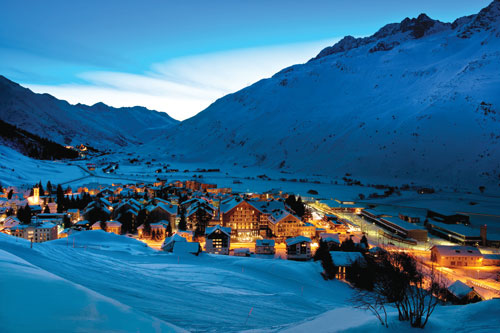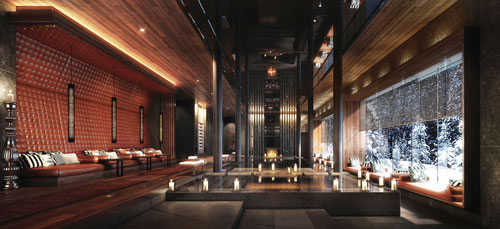Raini Hamdi visits The Chedi Andermatt and discovers a thrilling story of a real purpose behind an unreal world of jaw-dropping luxury
Every once in a while, an astonishing development comes along and makes a statement for a destination. The Guggenheim Museum did it for Bilbao in Spain, Marina Bay Sands for Singapore, The Burj Al Arab for Dubai. And now I dare say The Chedi Andermatt can be counted in this elite group, its opening last December not only reviving a forgotten valley but changing the style of resort vacationing in the Swiss Alps.
I did not expect it to be this significant. After all, how much would it take for an international, modern Chedi to create a difference in a conservative Swiss mountain village where flowers-laden, sun-blackened wooden hotels or others covered with shingles are the norm? So as my partner drove me to Andermatt, I was not filled with anticipation – the Chedi had done its job for Andermatt long before I arrived – but I was eager to see Andermatt itself while Kurt was already sentimental about revisiting the valley which helped form him as a man. Andermatt was the centre of the Swiss Army in the Alps and in his military days my Kurt was there as a chef in charge of cooking for a company of 150 men. Andermatt instilled in him a love for the mountains and taught him how to walk up and down them like a Gemse, come rain or snow.

An-der-matt. It is not Zermatt, St Moritz, Arosa or Gstaad, mountain resort destinations which need no introduction as playgrounds for the rich to hobnob with one another. Andermatt, on the other hand, requires quite some explanation and, even though it has riveting rags to riches stories to tell, no one had bothered to listen. Until now.
The largest settlement in the long and lusciously green Urseren Valley, Andermatt actually has a long history of hospitality. The opening of the Gotthard Road in 1830 brought a wave of travellers passing through the valley in summer and winter, and with it, the opening of the first hotel in Andermatt, Hotel St Gotthard, in 1854, and its first luxury property, Hotel Bellevue, in 1872. The health of the hotel industry became rosy; alas this lasted only a decade because the village was bypassed when the railway tunnel through the Gotthard opened in 1882. In the early 1900s, Andermatt took off again as a ski resort destination, catering to lots of British guests who pioneered winter holidays in the Alps. But the second World War decimated the image of Andermatt as a luxury destination and in the years that followed, it became synonymous as a military base, with the valley and its mountains being the grounds for army training until 1998.

Andermatt was in an economic black hole when the army moved out, as the military provided lots of jobs to the village. The knight in shining armour came in the form of an Egyptian entrepreneur, Samih Sawiris of the Orascom empire, whose main businesses are telecommunications and construction. He was welcomed with open arms by the local population who voted to let him build, over time, six hotels with some 3,000 beds, 42 apartment blocks, 20-30 villas, an indoor swimming pool, an 18-hole golf course and a new ski resort – the largest in central Switzerland – linking the Andermatt and Sedrun ski areas. The total investment is reportedly more than 1.8 billion Swiss francs (US$2 billion) if these projects all materialise.
The Chedi Andermatt, with 105 rooms and suites, along with the golf course, is the first of these to open, and if Sawiris had intended the hotel’s opening to strike awe among those who behold it, that aim is a bullseye. There is nothing like it in Swiss Alps and it is nothing like any Chedi I know, not even the grander ones in Oman or Vietnam. It is by no means a Frank Gehry or a Moshi Safdie eye-popping starscrapper; in fact, the building is rather nondescript. Like a Steinbock perched on a mountain, it stealthily blends into the village, its exterior reminding me of a church organ made of wood.
But what’s inside is magnificent – the lobby scales a height, width and length that feel monumental and every facility be it the pool or the suite looks larger than life, everything glitters although nothing is gold. It employs the best technology and the best quality at every turn. The design has Jean-Michel Gathy’s Chedi hallmarks of contemporary elegance and minimalist style but without doubt this is the ultimate Chedi.
This must be how it was when the Badrut Palace in Moritz, or the Tschuggen Grand Hotel in Arosa, opened years before, jaw-dropping pieces of their time that draw the rich and famous till today. Dining in the main restaurant of the Chedi, which twinkles with no fewer than 480 lightbulbs from a dozen modern chandeliers hanging on the ceiling, the young and old wealthy are here to see and to be seen.

Discombobulated by the scale of luxury, my mind went into defence mode with a barrage of questions: Does this thing fit in a small and modest community like Andermatt? Shouldn’t it have more Swiss ‘sense of place’? Is it a good idea to have a largely young, international crew who further perpetuates the absence of a homely, ‘Swiss-ly’ hospitality one would normally experience in the Alps?
But like all icons, I realised the Chedi sets its own rules. It tells you what luxury is and, before long, you will surrender, just as those before us had to at each of the grand hotels that had opened in the Alps throughout its long history of tourism.
Befittingly, the Chedi Andermatt sits on the site of the former Hotel Bellevue, setting the new foundation for the an old valley. I’m thrilled for the region. The Urseren Valley has lots to offer to international tourists. James Bond movie buffs could relive a scene from Goldfinger by driving through the bends on Furka Pass, while those who love to walk or hike will be spoilt by both gentle and more strenuous trails amid some of the most breathtaking mountain sceneries in Switzerland. And the Swiss Army left one gem of an attraction within reach of Andermatt, Sasso da Pigna, a mountain that hid men and artillery during World War II, which was kept a secret until 2001. Today, the public could walk its 2.5km tunnels, see the dormitories, the cannons and combat positions – now I not only have hiked up, down and on a mountain, but inside it. In just the few days I was in Andermatt, I left richer from the experience.
Andermatt is the new holiday address in Switzerland. For me it is everything Switzerland is: small – yet resilient, lucky and hard to be sidelined or forgotten.




















